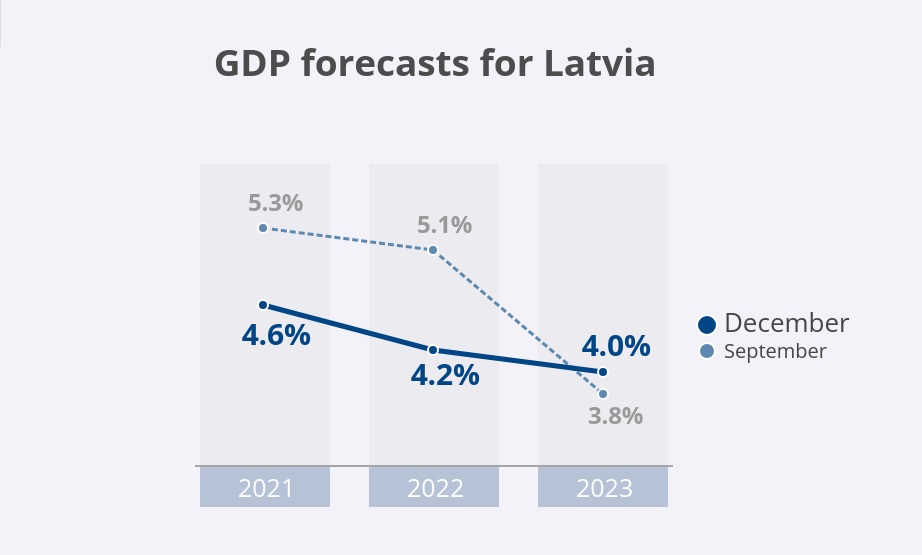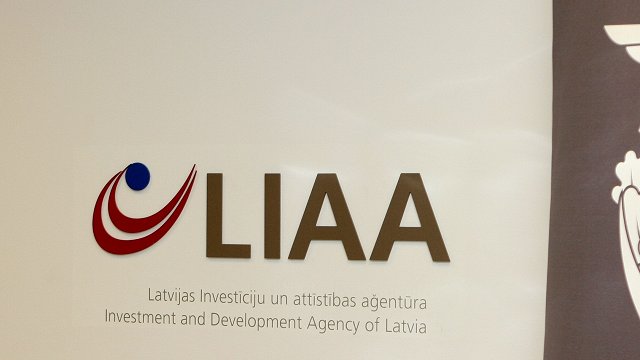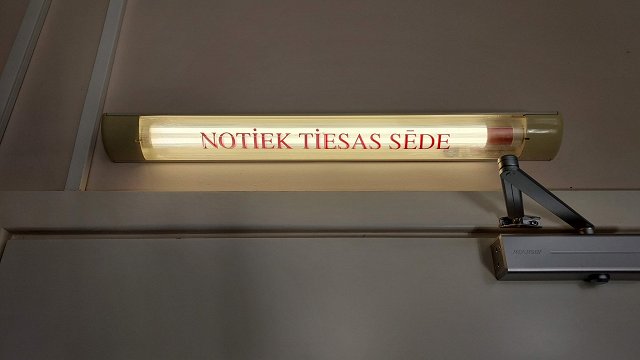Latvia's GDP growth projections for 2021 and 2022 have both been revised downwards to 4.6% and 4.2% respectively (from 5.3% and 5.1% in September 2021 forecasts), reflecting the economic fallout from the pandemic. The projected GDP growth for 2023 remains unchanged at 4.0%.
Meanwhile, inflation projections for 2021 and 2022 have been revised significantly upwards to 3.2% and 6.1% respectively (from 2.8% and 4.0% in September 2021 forecasts) in light of the soaring global energy prices.
An upward revision in inflation projections for 2023 to 2.9% was determined by an increase in production costs.
"Latvia's economic growth has decelerated towards the turn of the year on account of deteriorating epidemiological situation, as already projected in our September forecasts. Additional factors, however, were the imposed lockdown and tightened restrictions," LB said.
"Although private consumption recovered in the third quarter, an increase in traveller spending abroad is observed, with no contribution to Latvia's economic growth. Prices on building materials and equipment have risen to a larger extent than estimated in investment plans, thus dampening the investment activity. Restrictions on the provision of services put a continued downward pressure on exports."
"The economic effects of the pandemic will continue to be felt also at the beginning of next year. Considering the tight labour market, an additional downside factor will be the requirement to have a Covid-19 certificate for on-site workers, as well as deterioration of the epidemiological situation and restrictions in Europe."
The central bank expressed hopes that soaring energy prices and supply disruptions will fade significantly during the second half of 2022 and that the material shortages faced by Latvian businesses are not as acute as in other European countries.
|
Macroeconomic indicators: Latvijas Banka projections |
|||||
|
2021 |
2022 |
2023 |
2024 |
|
|
|
Economic activity (annual percentage changes; at constant prices; seasonally adjusted data) |
|||||
|
GDP |
4.6 |
4.2 |
4.0 |
3.3 |
|
|
Private consumption |
5.7 |
8.6 |
5.4 |
4.3 |
|
|
Government consumption |
7.9 |
3.9 |
0.5 |
0.7 |
|
|
Investment |
4.3 |
7.0 |
4.1 |
3.6 |
|
|
Exports |
5.4 |
4.5 |
5.0 |
3.2 |
|
|
Imports |
12.6 |
2.7 |
3.3 |
3.4 |
|
|
HICP inflation (annual percentage changes) |
|||||
|
Inflation |
3.2 |
6.1 |
2.9 |
2.1 |
|
|
Underlying inflation (excluding food and energy) |
2.0 |
3.1 |
2.6 |
2.3 |
|
|
Labour market |
|||||
|
Unemployment (% of the economically active population; seasonally adjusted data) |
7.8 |
7.5 |
6.8 |
6.6 |
|
|
Nominal gross wage (annual percentage changes) |
8.9 |
7.5 |
6.1 |
5.9 |
|
|
External sector |
|||||
|
Current account balance (% of GDP) |
–2.8 |
–1.8 |
–0.9 |
–1.1 |
|
|
Government finances (% of GDP) |
|||||
|
General government debt |
47.1 |
49.7 |
47.1 |
44.6 |
|
|
Budget surplus/deficit |
–8.2 |
–4.1 |
–1.3 |
–0.4 |
|
Underlying inflation is expected to increase, largely on account of rising wages.
"The near-term risks to the inflation projections, however, remain tilted to the upside. This is determined by the tight domestic labour market and an anticipated later decline in global prices on raw materials," LB warned.
"Unemployment is bound to increase on account of those refusing to vaccinate, as there is a requirement to have a valid Covid-19 certificate for on-site workers... The decreasing availability of the labor force strengthens the pressure on wages. The wage growth projections for 2023 have been revised upwards to reflect labor shortages and the planned reform of the public administration remuneration system," LB said.






























